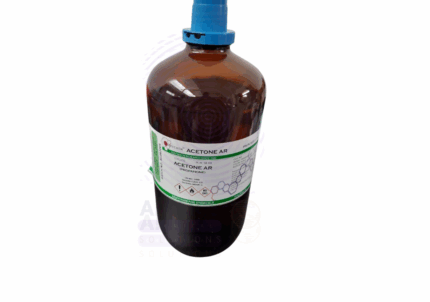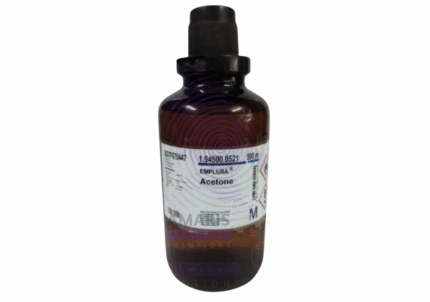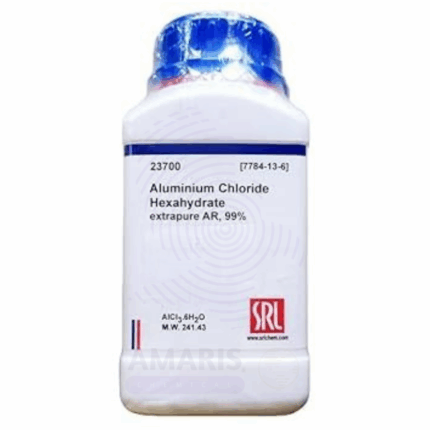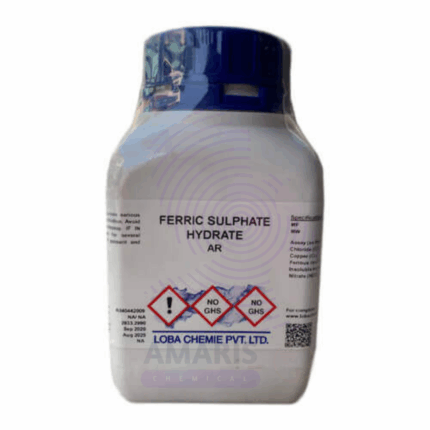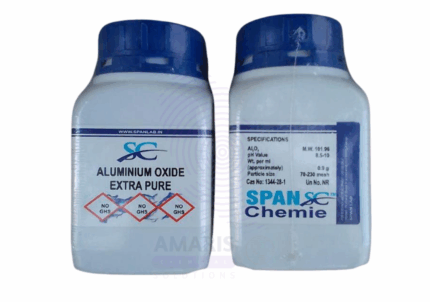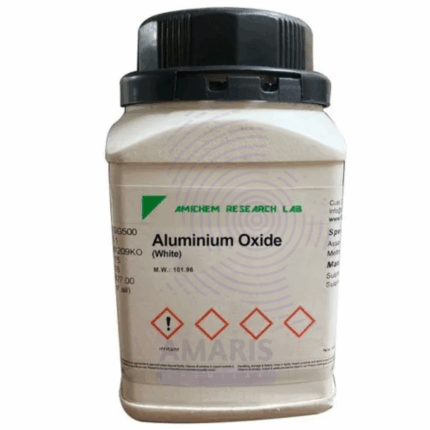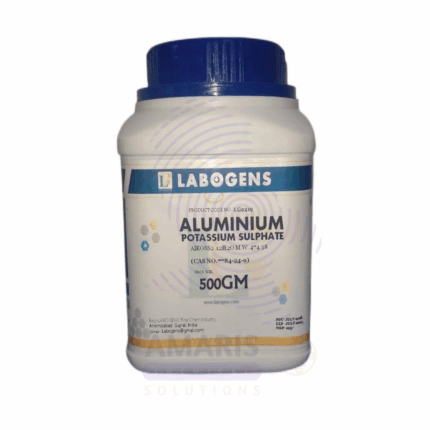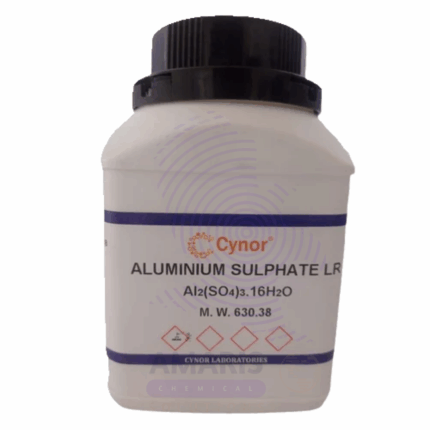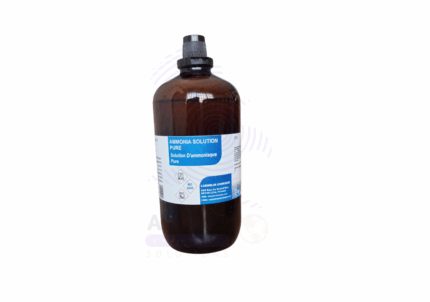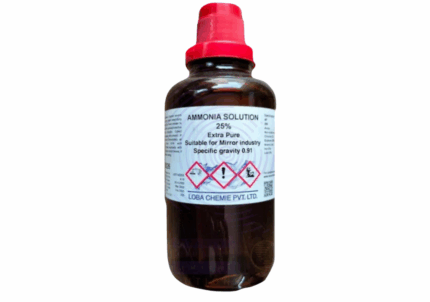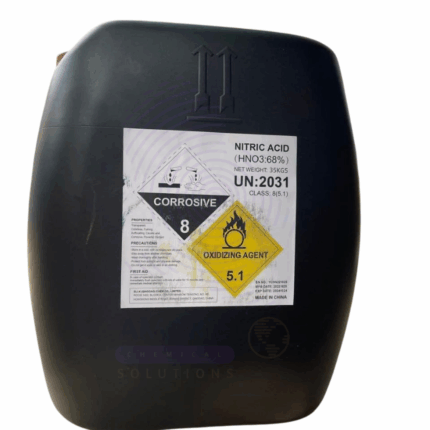
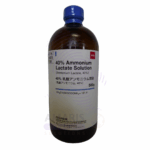
Ammonium Molybdate Extra Pure
$ 18.00 Original price was: $ 18.00.$ 17.76Current price is: $ 17.76.
Ammonium Molybdate Extra Pure, typically supplied as tetrahydrate ((NH4)6Mo7O24⋅4H2O), is a high-purity, white crystalline compound widely used in laboratory chemistry for analytical, inorganic, and materials science applications. It is most notably used in colorimetric analysis for detecting phosphates, silicates, and arsenates through the formation of characteristic molybdenum blue complexes. In catalysis and coordination chemistry, it serves as a precursor for molybdenum-based compounds and materials. Its extra pure grade ensures high accuracy and reproducibility in sensitive assays and research procedures. Ammonium molybdate should be stored in a tightly sealed container in a cool, dry place, protected from light and moisture to maintain its stability and effectiveness.
Ammonium Molybdate Extra Pure
Primary Uses
- Reagent in Phosphate Analysis (Colorimetric Test)
- Widely used in the molybdenum blue method to detect and quantify phosphate (PO₄³⁻) in water, soil, and food samples.
- Reagent for Silicate and Arsenate Detection
- Forms colored complexes with silicates and arsenates, allowing spectrophotometric or visual identification.
- Precursor in the Synthesis of Molybdenum Compounds
- Serves as a starting material for producing molybdenum oxides, catalysts, and coordination complexes.
- Catalyst Component in Laboratory-Scale Oxidation Reactions
- Acts as a heteropoly acid precursor or support material in oxidative catalysis research.
- Educational Demonstrations of Polyatomic Ion Chemistry
- Used to illustrate the behavior of polyoxometalates and large anionic structures in advanced chemistry classes.
Secondary Uses
- Chromogenic Agent in Clinical Chemistry Kits
- Found in diagnostic assays for phosphate and nucleotides in blood and urine analysis.
- Study of Molybdenum Redox Chemistry
- Involved in research on Mo⁶⁺ ↔ Mo⁵⁺/Mo⁴⁺ redox cycling, useful in coordination chemistry and material science.
- Corrosion and Metal Surface Treatment Research
- Used in the lab as a corrosion inhibitor model, particularly for steel and aluminum alloys.
- Crystal Growth and Solid-State Chemistry
- Studied for its crystallization behavior and phase transitions in molybdenum-based materials.
- Component in Heteropoly Acid Studies
- Participates in forming Keggin-type anions and other polyoxometalate structures, relevant to catalysis and supramolecular chemistry.
| PACK SIZE |
100 grams Plastic Tin |
|---|
1. Basic Identification Attributes
- Chemical Name: Ammonium Molybdate
- CAS Number: 13106-76-8 (tetrahydrate)
- HS Code: 28417000 (Molybdates; of ammonium or other metals)
- Molecular Formula: (NH₄)₆Mo₇O₂₄·4H₂O (commonly tetrahydrate)
- Synonyms:
- Ammonium heptamolybdate
- Ammonium molybdate tetrahydrate
- Heptamolybdic acid, hexammonium salt
- Ammonium paramolybdate
2. Physical & Chemical Properties
- Physical State: Solid (crystalline powder)
- Color & Odor: White to slightly green crystals; odorless
- Boiling Point: Decomposes
- Melting Point: Decomposes at ~190–200°C (releases ammonia and water)
- Density/Specific Gravity: ~2.498 g/cm³
- Solubility:
- Water: Soluble (~40 g/100 mL at 20°C)
- Alcohol: Insoluble
- pH Level: ~5.0–6.0 (5% aqueous solution)
- Vapor Pressure: Negligible
- Flash Point: Not flammable
- Autoignition Temperature: Not applicable
- Viscosity: Not applicable
3. Safety & Hazard Attributes
- Hazard Class (GHS):
- Eye Irritation (Category 2A)
- Skin Irritation (Category 2)
- Acute Toxicity – Oral (Category 4)
- Specific Target Organ Toxicity – Repeated Exposure (Category 2, liver and kidneys)
- NFPA Ratings:
- Health: 2
- Flammability: 0
- Reactivity: 0
- Exposure Limits:
- OSHA PEL (as soluble molybdenum): 5 mg/m³
- ACGIH TLV: 0.5 mg/m³ (inhalable fraction, TWA)
- Reactivity:
- Stable under normal lab conditions
- Incompatible with strong reducing agents
4. Storage & Handling Attributes
- Storage Conditions:
- Store in tightly sealed containers in a cool, dry place
- Avoid exposure to heat and moisture
- Incompatible Materials:
- Strong acids and reducing agents (e.g., aluminum, magnesium, hydrides)
- Container Type:
- Plastic or amber glass jars
- Shelf Life & Expiration Date:
- ~2–3 years when stored dry
- Special Handling Requirements:
- Use gloves and eye protection
- Avoid dust inhalation; handle in fume hood if necessary
5. Regulatory & Compliance Attributes
- Regulatory Status:
- Listed under TSCA and REACH
- Considered hazardous under some local regulations due to heavy metal content
- Transportation Restrictions:
- Not classified as hazardous for transport in standard lab quantities
- Waste Disposal Method:
- Collect for heavy metal waste disposal
- Do not dispose in sinks or drains
6. Environmental & Health Impact
- Ecotoxicity:
- Harmful to aquatic organisms in large quantities
- Persistence in Environment:
- Molybdenum compounds are persistent and bioaccumulative
- Carcinogenicity/Mutagenicity:
- Not classified as carcinogenic
- Biodegradability:
- Inorganic; not biodegradable, accumulates in soil and water
SAFETY PRECAUTIONS
- Personal Protective Equipment (PPE):
- Wear a lab coat, chemical-resistant gloves (e.g., nitrile), and safety goggles.
- Use a fume hood or ensure adequate ventilation—avoid inhalation of dust.
- Handling:
- Avoid inhalation, ingestion, and skin or eye contact.
- Handle in a manner that minimizes dust formation.
- Keep away from acids (may release toxic molybdenum oxides) and reducing agents.
- Storage:
- Store in a tightly closed container in a cool, dry, well-ventilated area.
- Protect from moisture—compound may degrade upon prolonged exposure.
- Keep away from incompatible materials like strong acids and oxidizers.
- Hygiene Measures:
- Wash hands thoroughly after use.
- Clean work surfaces after handling.
- Avoid eating, drinking, or smoking while handling the chemical.
FIRST AID MEASURES
- Inhalation:
- Move person to fresh air.
- If breathing is difficult, administer oxygen.
- Seek medical attention if symptoms such as coughing or shortness of breath develop.
- Skin Contact:
- Remove contaminated clothing.
- Wash affected skin with plenty of soap and water.
- Get medical advice if irritation develops.
- Eye Contact:
- Rinse immediately with plenty of water for at least 15 minutes.
- Hold eyelids apart and remove contact lenses if present.
- Seek immediate medical attention.
- Ingestion:
- Rinse your mouth thoroughly with water.
- Do not induce vomiting unless instructed by medical personnel.
- Give water to dilute (if the person is fully conscious).
- Seek medical attention immediately—molybdenum salts may cause gastrointestinal irritation and systemic effects.
FIRE FIGHTING MEASURES
- Suitable Extinguishing Media:
- Use dry chemical, CO₂, foam, or water spray depending on surrounding fire conditions.
- Specific Hazards:
- Ammonium molybdate is non-combustible, but heating may cause decomposition, releasing:
- Ammonia
- Nitrogen oxides (NOₓ)
- Molybdenum oxides (MoO₃) — which are toxic.
- Ammonium molybdate is non-combustible, but heating may cause decomposition, releasing:
- Protective Equipment for Firefighters:
- Wear self-contained breathing apparatus (SCBA) and full protective clothing.
- Firefighting Instructions:
- Avoid inhalation of fumes or decomposition products.
- Use water spray to cool fire-exposed containers.
- Prevent runoff from contaminating drains—toxic to aquatic life in large quantities.


 Preservatives(food)
Preservatives(food) Flavor Enhancers
Flavor Enhancers Acidulants
Acidulants Sweeteners
Sweeteners Antioxidants
Antioxidants Colorants(food)
Colorants(food) Nutraceutical Ingredients (food)
Nutraceutical Ingredients (food) Nutrient Supplements
Nutrient Supplements Emulsifiers
Emulsifiers
 Collectors
Collectors Dust Suppressants
Dust Suppressants Explosives and Blasting Agents
Explosives and Blasting Agents Flocculants and Coagulants
Flocculants and Coagulants Frothers
Frothers Leaching Agents
Leaching Agents pH Modifiers
pH Modifiers Precious Metal Extraction Agents
Precious Metal Extraction Agents
 Antioxidants(plastic)
Antioxidants(plastic) Colorants (Pigments, Dyes)
Colorants (Pigments, Dyes) Fillers and Reinforcements
Fillers and Reinforcements Flame Retardants
Flame Retardants Monomers
Monomers Plasticizers
Plasticizers Polymerization Initiators
Polymerization Initiators Stabilizers (UV, Heat)
Stabilizers (UV, Heat)
 Antifoaming Agents
Antifoaming Agents Chelating Agents
Chelating Agents Coagulants and Flocculants
Coagulants and Flocculants Corrosion Inhibitors
Corrosion Inhibitors Disinfectants and Biocides
Disinfectants and Biocides Oxidizing Agents
Oxidizing Agents pH Adjusters
pH Adjusters Scale Inhibitors( water)
Scale Inhibitors( water)
 Antioxidants(cosmetic)
Antioxidants(cosmetic) Emollients
Emollients Fragrances and Essential Oils
Fragrances and Essential Oils Humectants
Humectants Preservatives
Preservatives Surfactants(cosmetic)
Surfactants(cosmetic) Thickeners
Thickeners UV Filters
UV Filters
 Fertilizers
Fertilizers Soil Conditioners
Soil Conditioners Plant Growth Regulators
Plant Growth Regulators Animal Feed Additives
Animal Feed Additives Biostimulants
Biostimulants Pesticides (Herbicides, Insecticides, Fungicides)
Pesticides (Herbicides, Insecticides, Fungicides)
 Active Pharmaceutical Ingredients (APIs)
Active Pharmaceutical Ingredients (APIs) Excipients
Excipients Solvents(pharmaceutical)
Solvents(pharmaceutical) Antibiotics
Antibiotics Antiseptics and Disinfectants
Antiseptics and Disinfectants Vaccine Adjuvants
Vaccine Adjuvants Nutraceutical Ingredients (pharmaceutical)
Nutraceutical Ingredients (pharmaceutical) Analgesics & Antipyretics
Analgesics & Antipyretics
 Analytical Reagents
Analytical Reagents Solvents(lab)
Solvents(lab) Chromatography Chemicals
Chromatography Chemicals Spectroscopy Reagents
Spectroscopy Reagents microbiology-and-cell-culture-reagents
microbiology-and-cell-culture-reagents Molecular Biology Reagents
Molecular Biology Reagents Biochemical Reagents
Biochemical Reagents Inorganic and Organic Standards
Inorganic and Organic Standards Laboratory Safety Chemicals
Laboratory Safety Chemicals Specialty Laboratory Chemicals(Special Laboratory Equipment)
Specialty Laboratory Chemicals(Special Laboratory Equipment)
 Demulsifiers
Demulsifiers Hydraulic Fracturing Fluids
Hydraulic Fracturing Fluids Scale Inhibitors(oil)
Scale Inhibitors(oil) Surfactants(oil)
Surfactants(oil) Drilling Fluids
Drilling Fluids
 Dyes and Pigments
Dyes and Pigments Bleaching Agents
Bleaching Agents Softening Agents
Softening Agents Finishing Agents
Finishing Agents Antistatic Agents
Antistatic Agents
 Admixtures
Admixtures Waterproofing Agents
Waterproofing Agents Sealants and Adhesives
Sealants and Adhesives Curing Compounds
Curing Compounds Concrete Repair Chemicals
Concrete Repair Chemicals Anti-Corrosion Coatings
Anti-Corrosion Coatings
 Surfactants(cleaning)
Surfactants(cleaning) Builders
Builders Enzymes
Enzymes Solvents (Cleaning)
Solvents (Cleaning) Fragrances
Fragrances
 Electronic Chemicals
Electronic Chemicals Catalysts
Catalysts Lubricants
Lubricants Photographic Chemicals
Photographic Chemicals Refrigerants
Refrigerants Automotive chemicals
Automotive chemicals Pyrotechnic Chemicals
Pyrotechnic Chemicals
 Biodegradable Surfactants
Biodegradable Surfactants Bio-based Solvents
Bio-based Solvents Renewable Polymers
Renewable Polymers Carbon Capture Chemicals
Carbon Capture Chemicals Wastewater Treatment Chemicals
Wastewater Treatment Chemicals
 Pigments
Pigments Solvents(paint)
Solvents(paint) Specialty Coatings
Specialty Coatings Binders/Resins
Binders/Resins Additives
Additives Driers
Driers Anti-Corrosion Agents
Anti-Corrosion Agents Functional Coatings
Functional Coatings Application-Specific Coatings
Application-Specific Coatings
 Fresh Herbs
Fresh Herbs Ground Spices
Ground Spices Whole Spices
Whole Spices Spice Blends
Spice Blends Dried Herbs
Dried Herbs
 Leavening Agents
Leavening Agents Dough Conditioners
Dough Conditioners Flour Treatments
Flour Treatments Fat Replacers
Fat Replacers Decoratives
Decoratives Preservatives(baking)
Preservatives(baking)
 Plasticizers & Softeners
Plasticizers & Softeners Reinforcing Agents
Reinforcing Agents Adhesion Promoters
Adhesion Promoters Vulcanizing Agents
Vulcanizing Agents Antidegradants
Antidegradants Blowing Agents
Blowing Agents Fillers & Extenders
Fillers & Extenders Accelerators & Retarders
Accelerators & Retarders

